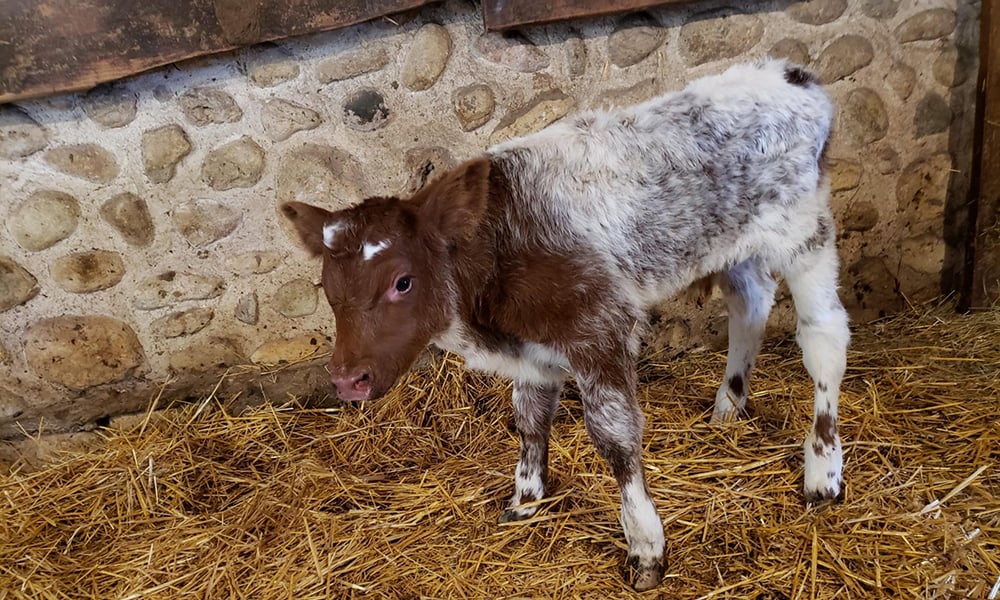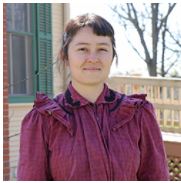
Since acquiring its first Heritage Milking Shorthorn cow, Liberty, in 2018, Kline Creek Farm’s herd of Heritage Milking Shorthorn cattle has been growing. The farm now has four animals in the herd, including Liberty’s daughter and granddaughter, who was born this past spring.
The farm’s goal has been to present the breeds of livestock people would have seen on an 1890s DuPage farm and help preserve them. In the 19th century, the Milking Shorthorn cow was one of the most popular and common breeds in the United States. Today, it is a rare and endangered breed, with fewer than 700 registered Heritage Milking Shorthorns in the U.S.
"Conservation breeding is important so we don't lose all these genetics," Carpenter said.
In 2019, Kline Creek Farm added another cow named Lady to the herd. She is a full Heritage Shorthorn, meaning that her pedigree traces back completely to the original 1822 herdbook. She had her first calf this year — a bull. We can’t keep the males because they would be too closely related to the other cows to use for breeding.

Lady, a full Heritage Shorthorn, was added to the herd in 2019 and had her first calf — a bull — in 2021.
Though we usually hope for births of heifers (females) to grow our herd, Tomlyn Farm in Albion, New York was happy to hear of the birth because they had requested to purchase a bull calf if we had one born this year.
So the bull calf was sold to Albion, New York, farm. Farm owners Tom and Lynda Fien say that these cattle have “a docile disposition, calving ease, are very maternal, and are good grazers.”

A Kline Creek Farm volunteer holds the bull calf born this year at Kline Creek Farm. It was sold to a farm in western New York.
“We’d like to do our part in conserving the breed,” the Fiens said. The bull calf made the trip to western New York in early September, and we are told he is settling in well. He has a lot of growing to do before he starts his career as a breeding bull.
Milking Shorthorns are dual-purpose cattle of English descent that were very popular in America in the 19th century. Dual purpose refers to cattle that produce milk and quality beef and are pasture-fed rather than grain-fed. In modern agriculture, cattle specialize in either beef or dairy and are typically grain-fed.

May is the granddaughter of Liberty, the first Heritage Milking Shorthorn to join the livestock at Kline Creek Farm in 2018.
Beginning around 1900, Shorthorn breeders split into beef and dairy strains. The historical dual-purpose Shorthorns are hard to find, as most breeders focused on turning them into beef cattle and those that stayed in dairy eventually added in Holstein genetics.
New this year, Kline Creek Farm has been presenting milking demonstrations at 9:30 a.m. each morning. Visitors still have time to catch a demonstration before we dry the cows off this fall on Nov. 16. Visit Kline Creek Farm’s Facebook page for the latest updates.
Visitors enjoy watching the demonstrations and learning about the source of their dairy products and how 1890s DuPage farmers could make a good living selling milk.

Liberty's daughter and granddaughter at Kline Creek Farm in West Chicago.

Liberty and her calf joined the livestock at the living history farm on May 1, 2018. thanks to the efforts of Lisa Carpenter, historical farming program coordinator at Kline Creek Farm in West Chicago.
Lisa Carpenter
